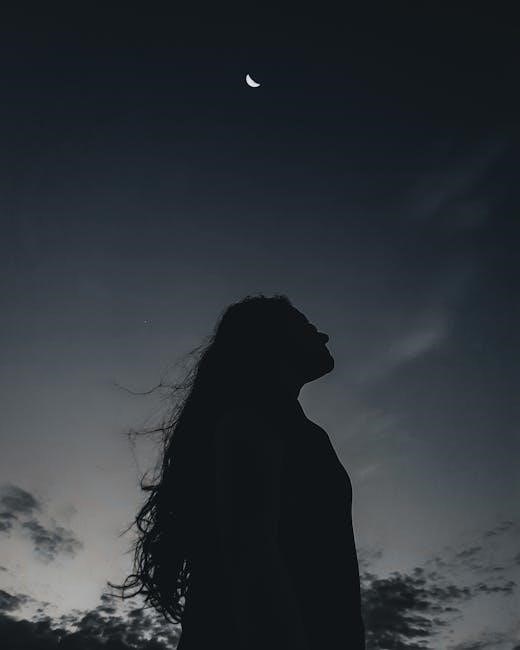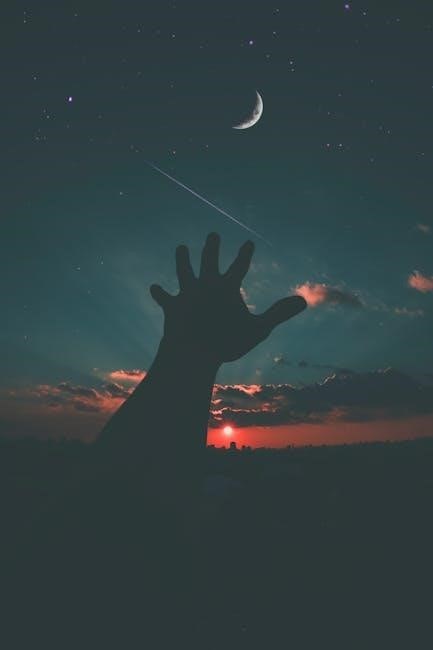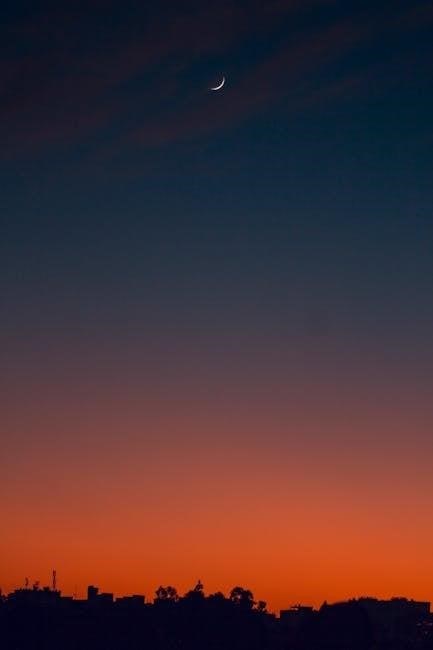Moon Salutation, or Chandra Namaskar, is a serene yoga sequence honoring lunar energy. It combines gentle poses, breathing techniques, and meditation, promoting relaxation and balance. Unlike Sun Salutation, it focuses on calming the mind and body, making it ideal for evening practice. This lesser-known flow nurtures introspection and harmony, offering a holistic approach to wellness. Discover its transformative power through guided PDF resources.
What is Moon Salutation?
Moon Salutation, or Chandra Namaskar, is a gentle, flowing yoga sequence inspired by lunar energy. It combines a series of poses, breathing techniques, and meditation to promote balance, relaxation, and inner harmony. Unlike Sun Salutation, which energizes, Moon Salutation calms the mind and body, making it ideal for evening practice. This holistic practice honors the moon’s cyclical nature, helping practitioners connect with their inner rhythms and foster emotional and physical well-being through mindful movement and breath awareness.
Importance of Moon Salutation in Yoga Practice
Moon Salutation holds significance in yoga as a practice that fosters balance, harmony, and inner peace. It complements Sun Salutation by offering a calming, meditative alternative, ideal for evening routines. This sequence promotes flexibility, strength, and circulation while nurturing emotional release and mental clarity. By synchronizing breath with movement, it cultivates mindfulness and reduces stress. Moon Salutation is a holistic practice that honors the moon’s energy, helping practitioners connect with their inner rhythms and achieve overall well-being.

Historical and Cultural Background
Moon Salutation, or Chandra Namaskar, originates from ancient yoga traditions, honoring the moon’s cycles. It reflects a deep cultural reverence for lunar energy, balance, and meditation.
Origins of Moon Salutation
Moon Salutation, or Chandra Namaskar, has its roots in ancient Indian yoga traditions, inspired by lunar cycles. It emerged as a counterpart to Sun Salutation, emphasizing cooling and calming energies. The sequence reflects the moon’s gentle glow and its influence on emotional balance. Historically, it was practiced during evening hours to promote relaxation and inner peace. This practice is deeply embedded in yoga philosophy, connecting practitioners with nature’s rhythms and fostering harmony within the body and mind. The origins highlight the holistic approach of yoga in balancing opposing forces, such as masculine solar energy and feminine lunar energy, creating a symphony of movements that honor the universe’s duality. By tracing its origins, we understand the cultural and spiritual significance of Moon Salutation in traditional yoga practices, making it a valuable ritual for modern yogis seeking balance and tranquility in their lives.
Cultural Significance in Yoga Tradition
Moon Salutation holds profound cultural significance in yoga, symbolizing reverence for the moon’s gentle power. It embodies the feminine, nurturing aspects of energy, balancing the masculine vigor of Sun Salutation. Rooted in ancient rituals, it honors the lunar cycle’s influence on human emotions and nature. This practice fosters introspection and harmony, reflecting yoga’s holistic philosophy. By embracing Moon Salutation, yogis connect with timeless traditions, celebrating the universe’s duality and the balance within. Its cultural essence lies in uniting spiritual and physical practices, enriching both mind and soul.

Benefits of Moon Salutation
Moon Salutation calms the mind, improves flexibility, and reduces stress. It promotes relaxation, balances energy, and enhances overall well-being, making it ideal for evening practice.
Physical Benefits
Moon Salutation enhances flexibility, improves balance, and relaxes muscles. It strengthens core stability, promotes proper posture, and eases muscle tension. Regular practice can also boost circulation and reduce physical stress, fostering overall well-being.
Mental and Emotional Benefits
Moon Salutation fosters emotional calm, reducing stress and anxiety. It encourages introspection, aiding in mental clarity and self-awareness. The practice helps balance emotions, promotes inner peace, and enhances mood, providing a therapeutic escape from daily pressures, and nurturing overall mental well-being through mindful movement and breath.

Comparison with Sun Salutation
Moon Salutation is the calming counterpart to Sun Salutation’s dynamic energy. It focuses on relaxation, typically practiced in the evening, while Sun Salutations energize during the day.
Similarities and Differences
Both Moon and Sun Salutations are flowing yoga sequences, but they differ in energy and purpose. Sun Salutations energize and warm the body, often practiced in the morning, while Moon Salutations cool and calm, typically done in the evening. Both involve synchronized breath and movement, but Moon Salutations emphasize relaxation and introspection, whereas Sun Salutations focus on building internal heat and vitality. While their structures share similarities, their intentions and impacts on the body and mind are distinct.
When to Choose Moon Salutation Over Sun Salutation
Opt for Moon Salutation when seeking relaxation, calmness, or balance. It is ideal for evening practice to unwind and prepare for rest. Unlike Sun Salutation, which energizes, Moon Salutation cools the body and mind, making it perfect for reducing stress or promoting introspection. Choose it when you need to calm your nervous system, enhance flexibility gently, or foster a meditative state. It is particularly beneficial during the full moon or when aiming to harmonize with lunar energy.
When to Practice Moon Salutation
Practice Moon Salutation in the evening or night to align with lunar energy. It is ideal during the full moon or when seeking relaxation and balance.
Best Times of Day
The best times to practice Moon Salutation are during the evening or night, aligning with the calming energy of the moon. Early morning can also be suitable, especially during the waxing crescent phase, to set intentions for the day. Avoid practicing during peak sun hours, as it may disrupt the soothing effects. Ideal moments include just after sunset or before bedtime to enhance relaxation and prepare for restful sleep; Consistency is key for optimal benefits.
Practicing During Different Phases of the Moon
Moon Salutation can be tailored to the lunar cycle, enhancing its spiritual and energetic benefits. The new moon is ideal for setting intentions, while the waxing moon supports growth and expansion. During the full moon, the practice can celebrate abundance and release, and the waning moon encourages surrender and introspection. Aligning your practice with the moon’s phases fosters harmony and mindfulness, deepening your connection to nature’s rhythms and your inner self.

Step-by-Step Guide
Moon Salutation offers a detailed, flowing sequence of poses, breathwork, and transitions, guiding practitioners through a harmonious and meditative yoga flow, perfect for balancing energy and calmness.
Preparation and Alignment
Begin by creating a serene and sacred space for your Moon Salutation practice. Use a yoga mat for comfort and stability. Wear loose, comfortable clothing that allows free movement. Ensure proper hydration before starting. Center your breath to calm the mind and focus your intention. Align your body mindfully, engaging your core for balance. Pay attention to posture to avoid strain. Transition smoothly between poses, honoring the natural flow. Conclude with a moment of gratitude to enhance the experience.
Sequence of Poses
The Moon Salutation sequence begins in Mountain Pose, transitioning into Half Moon Pose to stretch the spine and hips. Flow into Cat-Cow to warm up the neck and back, then move into Downward Dog for a full-body stretch. Shift into Cobra Pose to open the chest, followed by Seated Forward Bend to lengthen the hamstrings. End with Seated Spinal Twist to enhance flexibility and balance. Each pose is held for a few breaths, fostering a meditative flow and deep relaxation.
Transitioning Smoothly Between Poses
Transitioning smoothly in Moon Salutation involves synchronizing breath with movement, ensuring a fluid flow. Move slowly and mindfully, pausing briefly between poses to maintain balance. Use inhalations to open the chest and exhalations to deepen stretches. Keep your gaze steady and focus on alignment to prevent wobbling. Practice with a calm, steady pace, allowing each pose to emerge naturally from the previous one. This harmonious approach enhances the meditative quality of the sequence, fostering a deeper connection to your inner rhythm.

Modifications for Different Levels
Moon Salutation can be modified to suit all levels. Beginners can use blocks or move slower, while advanced practitioners can add complex flows or deeper stretches.
Beginner Modifications
Beginners can modify Moon Salutation to suit their flexibility and strength. Use blocks for support in low lunges or forward bends. Slow down the flow and hold poses longer for stability. Avoid deep twists or complex balances initially. Replace challenging poses like Lunges or Side Bends with simpler alternatives. Focus on proper alignment and breath synchronization. Listen to your body and rest when needed. This approach ensures a safe and enjoyable practice for newcomers.
Intermediate Variations
Intermediate practitioners can enhance their Moon Salutation practice by incorporating deeper stretches and dynamic movements. Hold poses slightly longer to build strength and flexibility. Introduce balance poses like Tree or Warrior II for added challenge. Smooth transitions between poses, synchronized with breath, create a flowing meditative experience. This level allows for deeper exploration of lunar energy, fostering both physical and mental harmony while maintaining the sequence’s calming essence.
Advanced Enhancements
For advanced practitioners, Moon Salutation can be elevated by adding complex poses and prolonged holds. Incorporate Crow Pose or Wheel Pose for strength and flexibility. Dynamic movements, such as flowing between Warrior II and Triangle Pose, enhance the sequence’s fluidity. Advanced breathwork, like Kapalabhati or Bhramari, deepens the meditative state. Incorporating bandhas (energy locks) intensifies the practice, connecting body and mind. This level challenges balance, focus, and endurance, fostering a profound sense of inner harmony and control.

Breathing Techniques
Breathing is central to Moon Salutation, enhancing its calming effects. Use Nadi Shodhana to balance energy and Ujjayi for smooth flow. Conscious breath connects mind and movement, fostering tranquility and depth in practice. Proper technique ensures a meditative experience, aligning breath with each pose seamlessly for inner harmony. Regular practice strengthens respiratory health and mental focus, making breath the cornerstone of this lunar sequence.
Importance of Breath in Moon Salutation
Breath is the essence of Moon Salutation, connecting movement and mindfulness. It harmonizes the body’s energy, fostering relaxation and balance. Techniques like Nadi Shodhana and Ujjayi create a meditative flow, calming the mind and enhancing focus. Proper breathing aligns with each pose, ensuring a smooth transition and deeper practice. It reduces stress, improves respiratory health, and strengthens mental clarity, making breath the cornerstone of this lunar sequence’s transformative power.
Specific Breathing Practices
Specific breathing practices in Moon Salutation include Nadi Shodhana (Alternate Nostril Breathing) and Ujjayi (Ocean Breath). Nadi Shodhana balances the body’s energy, while Ujjayi creates a soothing sound that enhances focus. Box Breathing, inhaling for four counts, holding, exhaling, and holding again, calms the mind. These techniques help synchronize breath with movement, ensuring smooth transitions between poses and deepening the meditative experience. Proper breathing aligns with the lunar energy, fostering harmony and inner peace during practice.

Mantras and Meditation
Mantras like “Om Shanti” enhance focus, while meditation deepens mindfulness. These practices harmonize breath, movement, and intention, fostering a meditative state and emotional balance during Moon Salutation.
Incorporating Mantras
Mantras like “Om Shanti” or “Om Mani Padme Hum” are powerful tools in Moon Salutation. Chanting these during practice enhances focus, calms the mind, and connects you to the flow. The repetition of mantras synchronizes with breath and movement, creating a meditative rhythm. They help in setting intentions, fostering mindfulness, and amplifying the therapeutic benefits of the practice. Use these sacred sounds to deepen your experience and align with the lunar energy.
Meditation Practices to Enhance the Experience
Meditation is a beautiful way to deepen your Moon Salutation practice. Begin by setting an intention, such as cultivating calm or gratitude. As you move through the sequence, focus on synchronizing your breath with each pose. Pause between poses to observe sensations in your body and mind. End with a seated meditation, observing your breath or repeating a mantra. This practice grounds your flow, fosters mindfulness, and creates a meditative rhythm, enhancing both physical and mental well-being.

Resources and Guides
Find comprehensive Moon Salutation PDF guides online, offering step-by-step instructions, pose illustrations, and meditation tips. These resources are perfect for practitioners seeking to deepen their practice at home.
Where to Find Moon Salutation PDFs
Moon Salutation PDFs are widely available online. Visit reputable yoga websites, wellness platforms, and online archives for detailed guides. Many sites offer free downloads, while others provide premium versions with enhanced visuals and instructions. Use specific keywords like “Moon Salutation PDF guide” or “Chandra Namaskar sequence download” to find the best resources. These PDFs often include step-by-step poses, breathing techniques, and meditation tips, making them ideal for both beginners and advanced practitioners seeking to deepen their practice.
Recommended Reading and Videos
Enhance your Moon Salutation practice with recommended reading and videos. Explore books on yoga that dedicate chapters to Chandra Namaskar, offering in-depth insights and visuals. Online platforms like YouTube and specialized yoga websites provide detailed video tutorials, demonstrating poses and transitions. Channels dedicated to yoga often feature Moon Salutation flows, while websites like [insert examples] offer comprehensive guides. These resources are perfect for visual learners and those seeking to refine their practice with expert guidance.
Moon Salutation is a transformative practice fostering balance and harmony. Its gentle flow cultivates mindfulness and inner peace, enhancing overall well-being. Embrace this holistic ritual for a serene experience.
Final Thoughts on Moon Salutation
Moon Salutation is a gentle yet profound yoga sequence that nurtures both body and mind. It offers a calming alternative to Sun Salutation, making it perfect for evening routines. By incorporating mindful breaths and meditative poses, it promotes relaxation and introspection. Regular practice can enhance flexibility, balance, and emotional well-being. Embrace the tranquility of Moon Salutation to reconnect with your inner self and find harmony in a hectic world.
Encouragement to Start Practicing
Embark on your Moon Salutation journey today and experience its transformative benefits. Whether you’re a beginner or an advanced practitioner, this sequence offers something for everyone. Its gentle flow and meditative essence make it accessible and rewarding. Start with a guided PDF to ensure proper alignment and technique. Consistency is key, so commit to regular practice and watch your body and mind flourish. Let Moon Salutation guide you toward greater peace and harmony in your daily life.

Call to Action
Download our comprehensive Moon Salutation PDF guide to deepen your practice. Join a yoga community or class to connect with like-minded practitioners and enhance your journey.
Download a Moon Salutation PDF Guide
Enhance your practice with a detailed Moon Salutation PDF guide. This comprehensive resource offers step-by-step instructions, illustrations, and tips for mastering the sequence. Whether you’re a beginner or advanced practitioner, the guide provides modifications and variations to suit your needs. Download now to deepen your understanding, improve your technique, and connect with the calming energy of the moon. Perfect for home practice or sharing with yoga communities.
Join a Community or Class
Connecting with a Moon Salutation community or class can deepen your practice and foster growth. Joining a group allows you to learn from experienced instructors, gain insights, and share experiences. Many yoga studios and online platforms offer Moon Salutation sessions, providing a supportive environment to explore its benefits. Engage with like-minded practitioners, ask questions, and refine your technique. Participating in a class or community enhances your understanding and helps you embrace the calming essence of this lunar practice fully.

Leave a Reply
You must be logged in to post a comment.